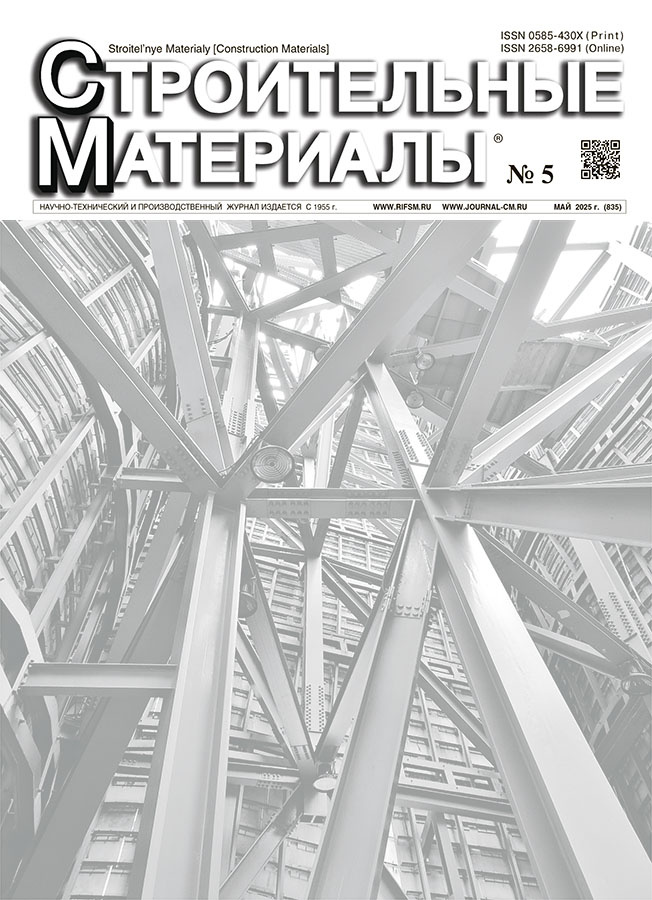Влияние энергетического потенциала фибры на структуру и свойства пенобетонов, изготовляемых по одностадийной технологии
- Авторы: Моргун Л.В.1, Нагорский В.В.1, Моргун В.Н.2
-
Учреждения:
- Донской государственный технический университет
- Южный федеральный университет
- Выпуск: № 5 (2025)
- Страницы: 68-72
- Раздел: Результаты научных исследований
- URL: https://clinpractice.ru/0585-430X/article/view/684063
- DOI: https://doi.org/10.31659/0585-430X-2025-835-5-68-72
- ID: 684063
Цитировать
Полный текст
Аннотация
Кратко отмечена актуальность развития технологии дисперсно-армированных пенобетонов и сформулирована цель работы. В рамках уточнения особенностей массопереноса, происходящего в пенобетонных смесях в период преобладания вязких связей между компонентами сырья, выделены свойства пенных пленок, зависящие от скорости фазового перехода, направлений перемещения жидкой фазы и влияющие на качество макроструктуры затвердевшего пенобетона. Предложена гипотеза обеспечения устойчивости дисперсной газовой фазы в структуре пенобетонных смесей, которая подтвердилась в ходе выполненных экспериментальных исследований. Научно обосновано возникновение электретного энергетического потенциала на поверхности полипропиленовой фибры при изготовлении пенобетонных смесей по одностадийной технологии. Установлено, что величина электретного эффекта зависит от расхода фибры и положительно влияет на технологические и физико-механические свойства пенобетонов.
Полный текст
Об авторах
Л. В. Моргун
Донской государственный технический университет
Автор, ответственный за переписку.
Email: konst-lvm@yandex.ru
д-р техн. наук
Россия, 344001, г. Ростов-на-Дону, пл. Гагарина, 1В. В. Нагорский
Донской государственный технический университет
Email: l_nag@bk.ru
аспирант
Россия, 344001, г. Ростов-на-Дону, пл. Гагарина, 1В. Н. Моргун
Южный федеральный университет
Email: vnmorgun@sfedu.ru
канд. техн. наук
Россия, 344006, г. Ростов-на-Дону, ул. Большая Садовая, 105/42Список литературы
- Нелюбова В.В., Строкова В.В. Технология силикатных прессованных материалов: обзор новаций для развития производства // Строительные материалы. 2019. № 8. С. 6–13. EDN: QRDGQK. https://doi.org/10.31659/0585-430X-2019-773-8-6-13
- Шембаков В.А. Задачи и перспективы развития российской стройиндустрии // Строительные материалы. 2024. № 3. С. 4–7. EDN: KKPBJW. https://doi.org/10.31659/0585-430X-2024-822-3-4-7
- Рабинович Ф.Н. Какой бетон нужен строителям? // Промышленное и гражданское строительство. 2015. № 2. С. 41–42. EDN: TIKDGN
- Горшков А.С., Пестряков И.И., Корниенко С.В., Ватин Н.И., Ольшевский В.Я. Фактические теплотехнические характеристики ячеистых бетонов автоклавного твердения // Строительство уникальных зданий и сооружений. 2018. № 5 (68). С. 75–104. EDN: YLUYNF. https://doi.org/10.18720/CUBS.68.7
- Горнов А.А. Индустриальное домостроение на основе легкого бетона // Жилищное строительство. 2021. № 5. С. 35–40. EDN: XVUNCZ. https://doi.org/10.31659/0044-4472-2021-5-35-40
- Королев А.С., Волошин Е.А., Трофимов Б.Я. Оптимизация состава и структуры конструкционно-теплоизоляционного ячеистого бетона // Строительные материалы. 2004. № 3. С. 30–32. EDN: IBEMKJ
- Вавренюк С.В., Рудаков В.П. Применение ячеистых бетонов в условиях юга Дальнего Востока России // Жилищное строительство. 2013. № 12. С. 6–8. EDN: RSEBQX
- Магдеев У.Х., Гиндин М.Н. Современные технологии производства ячеистого бетона // Строительные материалы. 2001. № 2. С. 2–5. EDN: IBEAFL
- Давидюк А.А., Фискинд Е.С., Гусарь О.А., Балакирева В.В. Преимущества в производстве и применении блоков из ячеистого бетона // Строительные материалы. 2018. № 12. С. 41–43. EDN: VPJMSW. https://doi.org/10.31659/0585-430X-2018-766-12-41-43
- Моргун В.Н., Моргун Л.В., Богатина А.Ю. Экспериментальная оценка наноэффектов в технологии пенобетонов // Строительные материалы. 2020. № 7. С. 45–48. EDN: OSYRZO. https://doi.org/10.31659/0585-430X-2020-782-7-45-48
- Мирюк О.А. Бесцементные поризованные композиции // Вестник Магнитогорского государственного технического университета им. Г.И. Носова. 2015. № 2. С. 101–107. EDN: TXHUEV
- Вилкова Н.Г. Свойства пен и методы их исследования: Монография. Пенза: ПГУАС, 2013. 120 с.
Дополнительные файлы










